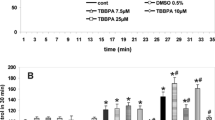Abstract
Rat cultured cerebellar granule neurons (CGNs) were not sensitive to CuCl2 (1-10 µM, 24 h), whereas paraquat (150 µM) decreased neuronal survival to 79 ± 3% of control level. Simultaneous treatment of CGNs with paraquat and CuCl2 (2, 5, or 10 µM Cu2+/paraquat) caused significant copper dose-dependent death, lowering their survival to 56 ± 4, 37 ± 3, or 16 ± 2%, respectively, and stimulating elevated production of free radicals in CGNs. Introduction of vitamin E, a non-competitive antagonist of NMDA subtype of glutamate receptors (MK-801), and also removal of glutamine from the incubation medium decreased toxicity of Cu2+/paraquat mixture. However, addition of Cu2+ into the incubation medium did not affect CGNs death caused by glutamate. These data emphasize that excessive copper in the brain may trigger oxidative stress, which in turn results in release of glutamate, overstimulation of glutamate receptors, and neuronal death.
Similar content being viewed by others
References
Stelmashook, E. V., Isaev, N. K., Genrikhs, E. E., Amelkina, G. A., Khaspekov, L. G., Skrebitsky, V. G., and Illarioshkin, S. N. (2014) Role of zinc and copper ions in the pathogenetic mechanisms of Alzheimer’s and Parkinson’s diseases, Biochemistry (Moscow), 79, 391–396.
Gaier, E. D., Eipper, B. A., and Mains, R. E. (2013) Copper signaling in the mammalian nervous system: synaptic effects, J. Neurosci. Res., 91, 2–19.
Kardos, J., Kovacs, I., Hajos, F., Kalman, M., and Simonyi, M. (1989) Nerve endings from rat brain tissue release copper upon depolarization. A possible role in regulating neuronal excitability, Neurosci. Lett., 103, 139–144.
Jomova, K., Vondrakova, D., Lawson, M., and Valko, M. (2010) Metals, oxidative stress and neurodegenerative disorders, Mol. Cell. Biochem., 345, 91–104.
Cartwright, G. E., and Wintrobe, M. M. (1964) Copper metabolism in normal subjects, Am. J. Clin. Nutr., 14, 224–232.
Linder, M. C. (1991) Biochemistry of Copper, Plenum Press, New York.
Isaev, N. K., Stelmashook, E. V., Dirnagl, U., Plotnikov, E. Yu., Kuvshinova, E. A., and Zorov, D. B. (2008) Mitochondrial free radical production induced by glucose deprivation in cerebellar granule neurons, Biochemistry (Moscow), 73, 149–155.
Eagle, H. (1959) Amino acid metabolism in mammalian cell cultures, Science, 130, 432–437.
Gallo, V., Ciotti, M. T., Aloisi, F., and Levi, G. (1982) Selective release of glutamate from cerebellar granule cells differen tiating in culture, Proc. Natl. Acad. Sci. USA, 79, 7919–7923.
McCaslin, P. P., and Morgan, W. W. (1987) Cultured cerebellar cells as an in vitro model of excitatory amino acid receptor function, Brain Res., 417, 380–384.
Stelmashook, E. V., Novikova, S. V., and Isaev, N. K. (2010) Glutamine effect on cultured granule neuron death induced by glucose deprivation and chemical hypoxia, Biochemistry (Moscow), 75, 1039–1044.
Gonzalez-Polo, R. A., Rodriguez-Martin, A., Moran, J. M., Niso, M., Soler, G., and Fuentes, J. M. (2004) Paraquat-induced apoptotic cell death in cerebellar granule cells, Brain Res., 1011, 170–176.
Cristovao, A. C., Choi, D. H., Baltazar, G., Beal, M. F., and Kim, Y. S. (2009) The role of NADPH oxidase 1derived reactive oxygen species in paraquat-mediated dopaminergic cell death, Antioxid. Redox Signal., 11, 2105-2018.
Stelmashook, E. V., Isaev, N. K., Plotnikov, E. Y., Uzbekov, R. E., Alieva, I. B., Arbeille, B., and Zorov, D. B. (2009) Effect of transitory glucose deprivation on mitochondrial structure and functions in cultured cerebellar granule neurons, Neurosci. Lett., 461, 140–144.
Liu, Y., Lu, L., Hettinger, C. L., Dong, G., Zhang, D., Rezvani, K., Wang, X., and Wang, H. (2014) Ubiquilin-1 protects cells from oxidative stress and ischemic stroke caused tissue injury in mice, J. Neurosci., 34, 2813–2821.
Stelmashook, E. V., Isaev, N. K., and Zorov, D. B. (2007) Paraquat potentiates glutamate toxicity in immature cultures of cerebellar granule neurons, Toxicol. Lett., 174, 82–88.
Isaev, N. K., Genrikhs, E. E., Aleksandrova, O. P., Zelenova, E. A., and Stelmashook, E. V. (2016) Glucose deprivation stimulates Cu2+ toxicity in cultured cerebellar granule neurons and Cu2+-dependent zinc release, Toxicol. Lett., 250/251, 29–34.
Su, X. Y., Wu, W. H., Huang, Z. P., Hu, J., Lei, P., Yu, C. H., Zhao, Y. F., and Li, Y. M. (2007) Hydrogen peroxide can be generated by tau in the presence of Cu(II), Biochem. Biophys. Res. Commun., 358, 661–665.
Samuele, A., Mangiagalli, A., Armentero, M. T., Fancellu, R., Bazzini, E., Vairetti, M., Ferrigno, A., Richelmi, P., Nappi, G., and Blandini, F. (2005) Oxidative stress and pro-apoptotic conditions in a rodent model of Wilson’s disease, Biochim. Biophys. Acta, 1741, 325–330.
Kumar, V., Kalita, J., Misra, U. K., and Bora, H. K. (2015) A study of dose response and organ usceptibility of copper toxicity in a rat model, J. Trace Elem. Med. Biol., 29, 269–274.
Gaetke, L. M., Chow-Johnson, H. S., and Chow, C. K. (2014) Copper: toxicological relevance and mechanisms, Arch. Toxicol., 88, 1929–1938.
Isaev, N. K., Stelmashook, E. V., Ruscher, K., Andreeva, N. A., and Zorov, D. B. (2004) Menadione reduces rotenone-induced cell death in cerebellar granule neurons, Neuroreport, 15, 2227–2231.
Rodriguez-Rocha, H., Garcia-Garcia, A., Pickett, C., Li, S., Jones, J., Chen, H., Webb, B., Choi, J., Zhou, Y., Zimmerman, M. C., and Franco, R. (2013) Compartmentalized oxidative stress in dopaminergic cell death induced by pesticides and complex I inhibitors: distinct roles of superoxide anion and superoxide dismutases, Free Radic. Biol. Med., 61, 370–383.
Stelmashook, E. V., Lozier, E. R., Goryacheva, E. S., Mergenthaler, P., Novikova, S. V., Zorov, D. B., and Isaev, N. K. (2010) Glutamine-mediated protection from neuronal cell death depends on mitochondrial activity, Neurosci. Lett., 482, 151–155.
Author information
Authors and Affiliations
Corresponding authors
Additional information
Original Russian Text © E. V. Stelmashook, E. E. Genrikhs, O. P. Aleksandrova, G. A. Amelkina, E. A. Zelenova, N. K. Isaev, 2016, published in Biokhimiya, 2016, Vol. 81, No. 8, pp. 1137-1144.
Rights and permissions
About this article
Cite this article
Stelmashook, E.V., Genrikhs, E.E., Aleksandrova, O.P. et al. NMDA-receptors are involved in Cu2+/paraquat-induced death of cultured cerebellar granule neurons. Biochemistry Moscow 81, 899–905 (2016). https://doi.org/10.1134/S0006297916080113
Received:
Revised:
Published:
Issue Date:
DOI: https://doi.org/10.1134/S0006297916080113




